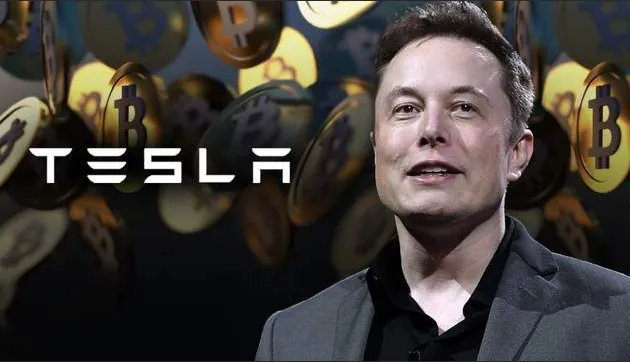The pursuit of privacy by crypto punks can be traced back to the birth of Bitcoin 16 years ago, which embedded privacy mechanisms within a completely transparent ledger, thus opening up the entire cryptocurrency world. To this day, privacy remains an important topic in the crypto space.
If you had bought ZEC at the first call by Mert, the "child of the version" in this round of the crypto market, and held it until now, you would have achieved a rare 20 times return in altcoins in less than 3 months.
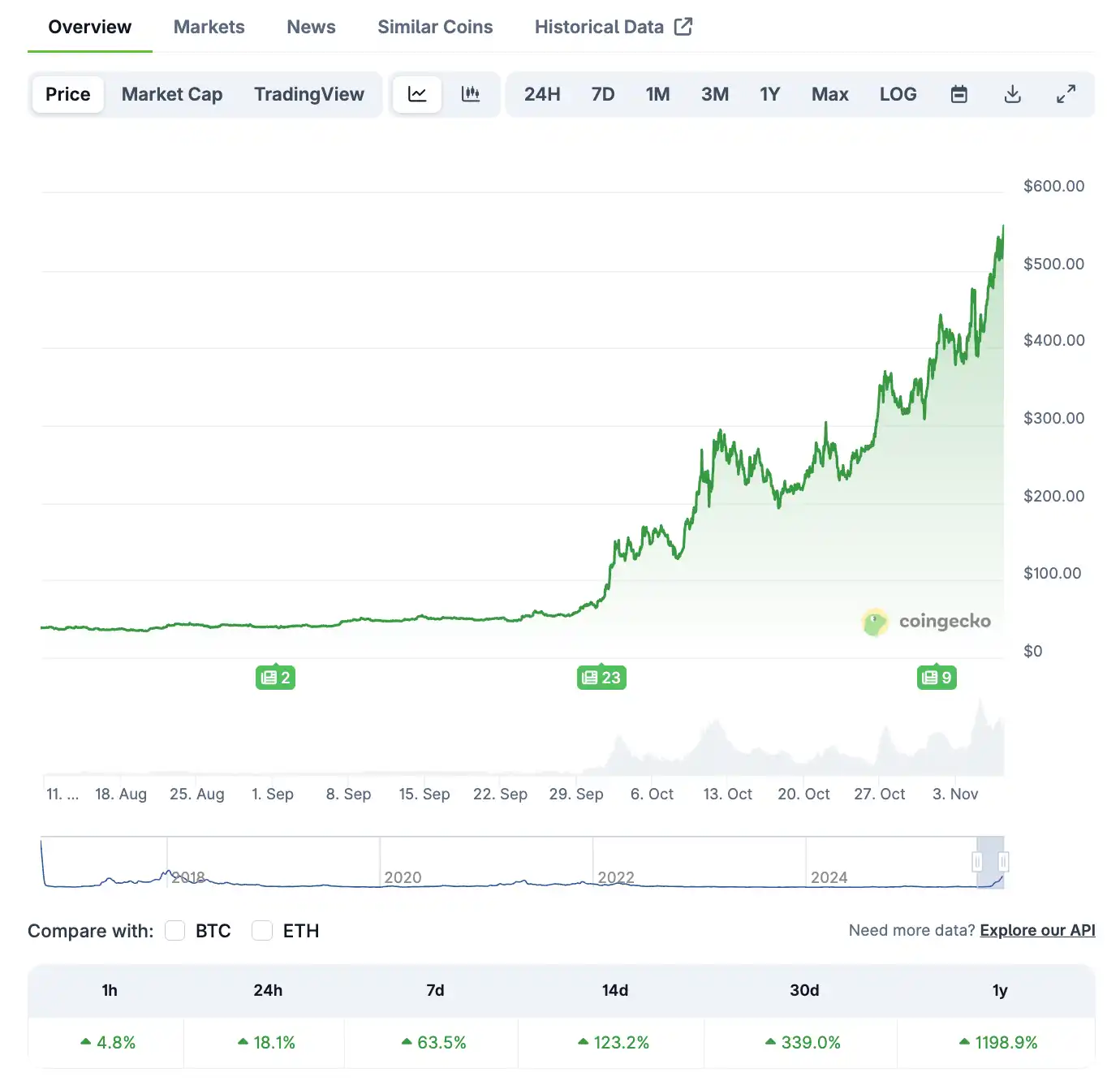
When ZEC skyrocketed from $238 to $580 in just 40 days, achieving a 20 times increase in three months and reaching a seven-year high, the crypto market realized that a long-forgotten sector was making a strong comeback. The entire privacy coin sector surged by about 80% in the past 7 days, with established projects like DASH, DCR, and ZEN seeing increases of over 100%.
Even more surprising was the shift in market sentiment. Just a few months ago, privacy coins were labeled as "regulatory orphans," with Kraken delisting XMR and the EU's 2027 ban draft causing investors to steer clear. But now, "privacy is a necessity, not a feature" has become a high-frequency topic on Twitter, with Arthur Hayes publicly stating a "ZEC target of $10,000" and Vitalik repeatedly endorsing ZKsync.
What is the real driving force behind this market trend? Is it the demand for safe-haven assets under regulatory pressure, or pure speculative trading? More importantly, how long can this wave of enthusiasm last?
Who is Leading the Charge?
ZEC is undoubtedly the absolute leader in this market trend. Starting from $237.84 on October 23, it reached $532.06 on November 7, achieving a 120% increase in just 40 days, with a cumulative increase of 700% for the year. This price not only set a new high since 2018 but also brought ZEC back into the sight of mainstream investors.
Looking back at several key points in time, we can clearly see the upward trajectory of ZEC:
October 1: Grayscale announced the reopening of the ZEC Trust (ZCSH) and offered fee reductions and staking features, causing ZEC to surge by 22% on the same day;
October 24: A "flag breakout" appeared in the technical pattern, with on-chain indicators OBV and CMF rising in sync, leading to a 40% increase in 4 days;
November 1: Open interest (OI) in futures first broke $770 million, and Arthur Hayes called out again with a "target of $10,000," triggering a short squeeze with a 15% increase in one day;
November 7: The price broke $532, with a 24-hour spot trading volume reaching $1.75 billion, 1.4 times the monthly average;
More noteworthy is the improvement in fundamentals: the balance of ZEC's shielded pool surpassed 5 million coins for the first time, accounting for about 30% of the circulating supply, equivalent to $2.5 billion in funds choosing a completely anonymous storage method. Daily transaction volume increased from 10,000 to 12,600, with the proportion of shielded transactions rising from less than 10% to 25-30%. These data indicate that ZEC's rise is not purely speculative but is supported by real privacy demand.
ZEC's strong performance has ignited the entire privacy sector, with a batch of once-forgotten legacy projects also experiencing a resurgence:
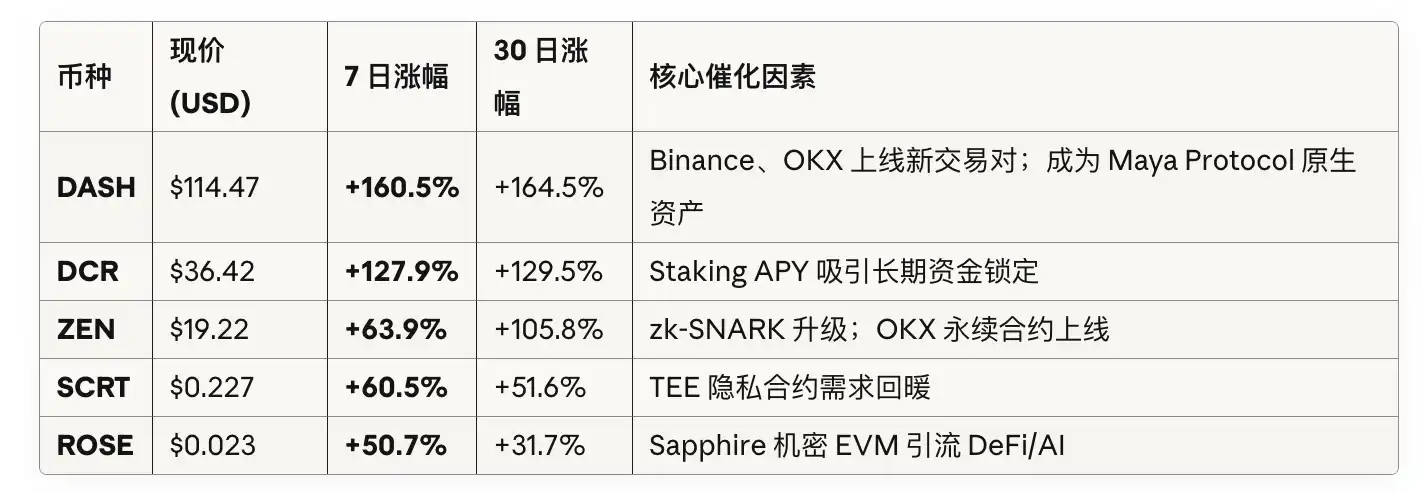
Behind this collective rise are two key drivers:
First is the concentrated new listings on trading platforms. From November 2-6, Binance, OKX, and Bitget successively launched perpetual contracts or new spot trading pairs for DASH, ZEN, and SCRT, bringing not only increased liquidity but also the amplification effect of high-leverage derivatives. For example, DASH's 24-hour spot and contract trading volume exceeded $1.2 billion, surging 2.8 times compared to the previous period.
Second is the substantial progress in technology or protocols. On November 2, DASH became the native asset of the Maya Protocol, achieving cross-chain anonymous swapping; ZEN completed its migration to Base L2, doubling zk-SNARK efficiency; SCRT and ROSE benefited from the new narrative combining privacy computing and AI.
In addition, there is a special player in the privacy sector: ZKsync (ZK).
From a technical perspective, ZK is a Layer-2 scaling solution for Ethereum, where transactions on the main chain remain transparent; however, due to its optional ZK privacy features and Prividium enterprise private chain, mainstream platforms like CoinGecko and Santiment categorize it within the privacy sector.
In the past 7 days, ZK has surged over 130%, becoming one of the top gainers in the privacy track. This performance is backed by three catalysts:
The performance leap from the Atlas upgrade: The Atlas upgrade, fully activated on November 1, increased theoretical TPS from 2,000 to 15,000-30,000, reducing ZK finality from 3 hours to 1 second, and lowering the cost per transaction from $0.0013 to below $0.0001. Previously, ZK's biggest limitation was its significantly higher cost compared to OP, but this issue has been greatly improved after the Atlas upgrade.
Reconstruction of the token economic model: The "ZKnomics Part I" proposal announced on November 4 first redirected network transaction fees and enterprise authorization fees back to the Treasury for "buyback-destroy + staking dividends," transforming ZK from a pure governance token into a cash flow asset. Estimated staking APY could reach 8-12%.
Vitalik's public endorsement: On November 1, Vitalik tweeted twice that ZKsync was "undervalued," leading to a 30-fold increase in ZK's trading volume on that day. The endorsement from a core figure played a crucial catalytic role in market sentiment.
What are the Rising Logics of the Privacy Narrative?
"Safe Haven Premium" Under Regulation
On the surface, tightening regulations should suppress privacy coins, but in reality, the opposite is true; it is precisely because of regulatory pressure that the demand for privacy has been stimulated.
The tightening of policies is accelerating. The EU's draft of the Anti-Money Laundering Regulation (AMLR) explicitly states that it will completely restrict the trading of privacy coins within the EU by 2027; the U.S. Financial Crimes Enforcement Network (FinCEN) also plans to intensify scrutiny of "high-risk self-custody addresses." With the spot ETFs for Bitcoin and Ethereum entering the regulatory spotlight, all on-chain transactions are facing stricter tracking.
As compliant assets become increasingly transparent, privacy assets are becoming scarce.
Thus, European and American media have even named this round of market activity as the "Crypto Anti-Surveillance Wave." ZEC and XMR are being redefined as "the last line of defense for on-chain anonymity." The consensus on social media is even more direct: "Privacy is not a feature, but a basic right."
On-chain data confirms the real growth in demand.
The balance of ZEC's shielded pool increased from 4 million coins to 4.9 million coins in 40 days, a growth of 25%; the proportion of shielded transactions rose from less than 10% to 25-30%, indicating that more and more users are choosing completely anonymous trading methods. The more users there are, the stronger the privacy guarantee, and the network effect becomes more apparent.

The increase in on-chain activity for ZEC, DASH, and ROSE is also significant evidence, with ZEC's daily transaction volume growing from about 10,000 on October 1 to 12,600 on November 7, a 26% increase. DASH's average daily on-chain transactions increased by 15% over 30 days, from about 1,300 to 1,500; ROSE surged by 200%, from about 3,300 to 10,000.
The TVL rebound of ZK is also noteworthy. After the Atlas upgrade was activated, the TVL of ZKsync Era rose from $500 million to $600 million, a 20% increase, achieved against the backdrop of a decline in the overall Layer-2 ecosystem's TVL.
Data on inflows to trading platforms also reflects the trend of chip locking. The net inflow of ZEC on trading platforms dropped sharply from $41.8 million to $3.66 million within 48 hours, a decrease of 91%. This indicates that holders are not short-term speculators but are optimistic about the long-term growth of privacy demand.
The Grayscale Effect of ZEC
The return of institutional funds is one of the most important catalysts for this market trend.
The restart of Grayscale's Grayscale ZEC Trust was the most significant event in October. On October 1, Grayscale announced the reopening of new subscriptions for the ZCSH Trust and provided two major upgrades: one is the waiver of management fees, and the other is the addition of staking features, offering an annualized return of 4-5%. This combination greatly improved the risk-reward ratio.
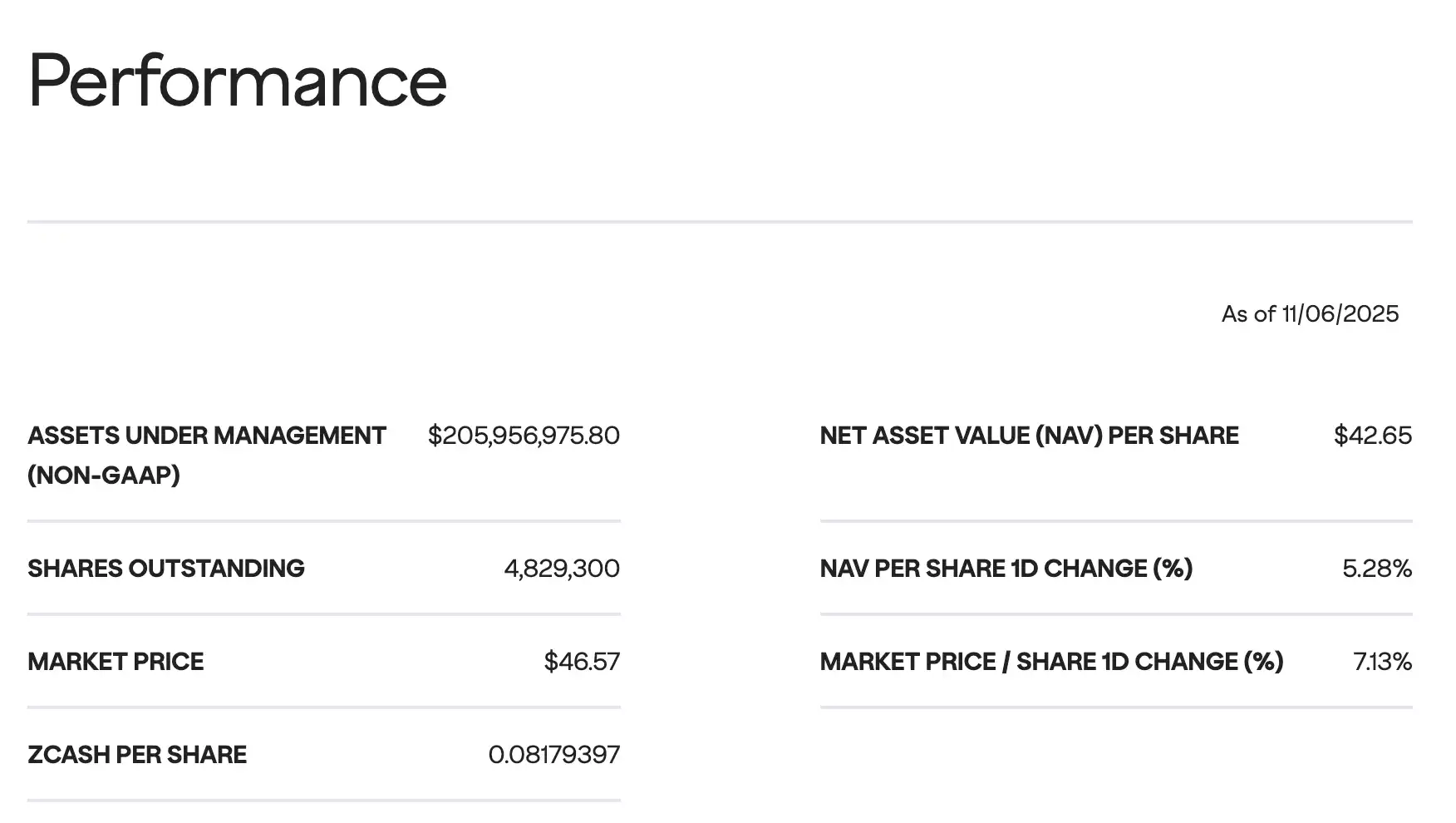
Why is the name "Grayscale" so valuable? Because for the past decade, Grayscale has been almost the only compliant bridge and price barometer for traditional institutions to allocate crypto assets. Its trusts issued in the U.S. have long provided crypto exposure for pensions, family offices, and hedge funds, making it a leading indicator of changes in institutional entry scale and preferences.
Since launching the first Bitcoin trust in 2013, Grayscale has successively laid out more than a dozen single-asset trusts for ETH, SOL, LTC, BCH, ETC, FIL, XLM, and others, many of which have experienced the typical "Grayscale effect"—fund inflows driving price increases, expanding premiums, and forming consensus narratives. The ZEC Trust (ZCSH) was established in 2017 and also saw a phase of skyrocketing premiums during the 2020-2021 bull market, becoming a major target for institutional allocation in the privacy sector.
However, due to tightening regulations and compliance pressures on privacy coins, ZCSH suspended subscriptions in 2022 and entered a period of dormancy in 2023. This restart signifies that Grayscale is once again endorsing privacy assets, and its signal significance even outweighs the funds themselves.
Data shows that the AUM (Assets Under Management) of ZCSH surged by 228% within a month, from about $42 million to $136 million, accounting for about 1.9% of ZEC's circulating supply. For an asset with a daily trading volume of hundreds of millions of dollars, nearly 2% of the chips being locked in the trust significantly tightens the supply side.
A deeper logic is the circumvention effect of ETFs. The approval of spot ETFs for Bitcoin and Ethereum has brought these assets into a strict regulatory framework, where every transaction is traceable. Some institutions and high-net-worth individuals, in order to avoid this transparency, have begun to shift their funds towards anonymous assets. Grayscale's ZEC Trust conveniently provides a compliant channel—allowing exposure to privacy coins while operating through traditional financial channels.
Common Position of the Version Children in the Crypto Space
Social media has played an amplifying role in this round of market activity.
During the rise of ZEC, Mert (@0xMert_), regarded as the version child of the Solana ecosystem in this round, was undoubtedly one of the most critical voices behind the price. As the CEO of Helius, a core infrastructure of Solana, and one of the most recognized voices in the Solana ecosystem, Mert began heavily recommending ZEC when it was at $30 and has continued to call for it almost daily on X, live streams, and podcasts. As a result, the ZEC community has greatly overlapped with the Solana community.
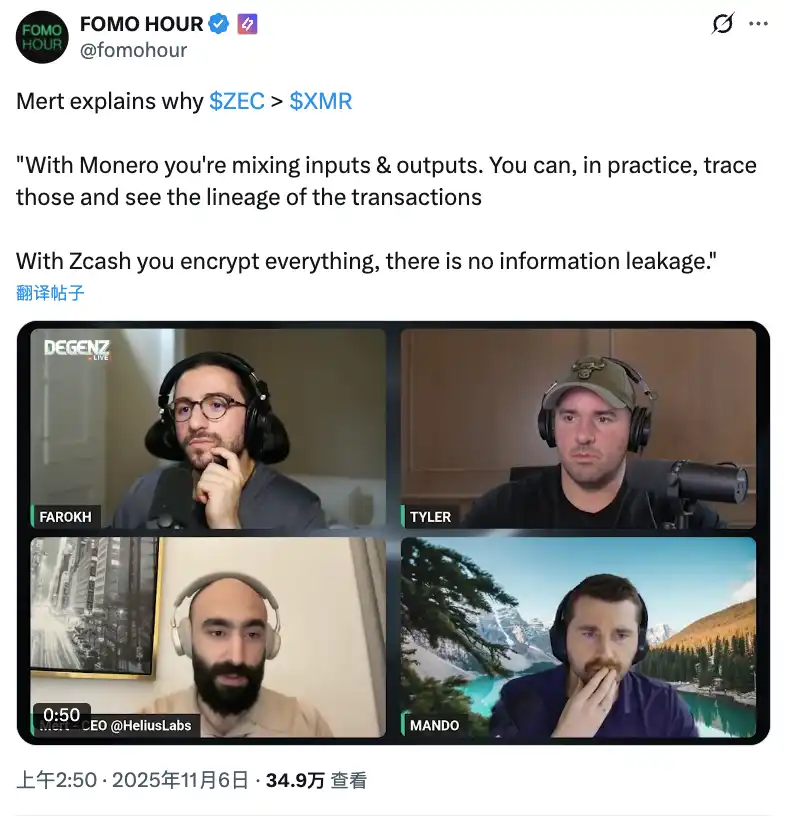
Even more catalytic was Arthur Hayes's continuous calls to enter the market. This co-founder of BitMEX is considered one of the "most prophetic individuals regarding cycle turns" in the last bull market. On October 31, he first threw out a "ZEC target of $1,000," which was already astonishing; then on November 1, he directly raised it to a "target of $10,000," positioning ZEC as "a safe-haven asset in the crypto market." This tweet garnered over 200,000 interactions in a single day, leading to a surge in ZEC's trading volume and a short-term increase of 15%.

Subsequently, Naval Ravikant's comments elevated the narrative of ZEC from "speculative asset" to a "battle of values and technology." Naval redefined the value foundation of privacy assets with the statement, "Privacy is a basic right, not a tool for crime."
As the "biggest fan of ZK," Vitalik tweeted on November 1 that ZKsync was "undervalued," directly driving a 30-fold increase in trading volume for ZK-related assets, fueling the ZK narrative, and "ZK Season is here" became a hot topic.

Is ZEC Really "Bitcoin Silver"?
In the rise of ZEC's price, the community has also presented a narrative of "Bitcoin Silver." Does this positioning really hold water?
Optimists believe that ZEC's rise is not solely due to the privacy narrative. A key piece of evidence is the divergence in market performance: if ZEC's rise were merely due to privacy demand, then RAIL, as a core privacy project in the EVM ecosystem, should have benefited simultaneously.

RAIL is a privacy protocol on the Ethereum ecosystem that can anonymize ETH, ERC-20 tokens, and NFTs. More importantly, Vitalik himself not only used RAIL to anonymize millions of dollars in ETH but also natively integrated RAIL into his new project Kohaku (a wallet SDK), with MetaMask and OKX wallets as partners. From a fundamental perspective, RAIL charges a fee of 0.25% for funds entering and exiting the privacy pool, and 77% of the token supply is staked and locked for 30 days, meaning the actual circulating supply is far lower than the surface data. This is a project with a clear business model and token economics, rather than a purely speculative target.
However, by mid to late October, a key signal emerged in the market: ZEC continued to soar while RAIL began to stagnate. This may indicate that ZEC's rise is not just about privacy, but rather that the market is re-evaluating its monetary attributes and value storage function. In other words, privacy may just be a catalyst; the real narrative is whether "ZEC can become the silver to Bitcoin"—a narrative with a higher ceiling.
Optimists believe that ZEC possesses all the elements to become "Bitcoin Silver." From a technical standpoint, ZEC uses a proof-of-work (POW) mechanism, ensuring network security through computational competition, which aligns more closely with the principle of "monetary neutrality"—no one can control the network through holding coins. ZEC's total supply is fixed at 21 million coins, and this hard cap supply mechanism is a core feature of value storage assets, avoiding the risk of inflation dilution. More critically, ZEC's privacy function is not a burden but an advantage: in a world where regulation is tightening and on-chain transactions are completely transparent, privacy is transitioning from "an optional feature" to "a monetary necessity." When every transaction of Bitcoin can be traced and every address can be tagged, ZEC's shielded transactions provide true substitutability—one of the most fundamental attributes of currency.
From a valuation perspective, optimists also point out that ZEC's market capitalization is still relatively low compared to Bitcoin, indicating significant revaluation potential. If ZEC is truly accepted by the market as a value storage asset, even capturing just 5-10% of Bitcoin's share would imply several times of upside potential. Historically, the value ratio of silver to gold has fluctuated between 1:50 and 1:80; if measured by the same logic, ZEC still has a significant valuation gap to close relative to Bitcoin.
However, pessimists present a completely different perspective.
They argue that if ZEC's value truly lies in "currency/value storage," then the real challenger to Bitcoin is Ethereum, not ZEC.
Ethereum not only has smart contracts, a vast DeFi ecosystem, and institutional recognition, but more importantly, it has effectively played the role of "programmable currency"—hundreds of billions of dollars in stablecoins circulate on Ethereum, and trillions of dollars in value are locked in Ethereum's DeFi protocols. In comparison, while ZEC has privacy and fixed supply, it lacks ecological depth and application scenarios, making it more like a "single-function tool" rather than "a versatile currency."
In this framework, pessimists are more optimistic about projects like Railgun. RAIL enhances Ethereum's privacy, effectively improving ETH's monetary attributes. This means RAIL is not only a beneficiary of the privacy narrative but also a beneficiary of Ethereum's monetary narrative—it stands on a larger, more mature ecosystem rather than trying to build a new monetary system from scratch.

From a valuation perspective, the potential for growth between the two shows a huge difference. If RAIL rises 20 times, its fully diluted valuation (FDV) will reach $4 billion, which is consistent with the valuations of other top projects in the Ethereum ecosystem, making it easy for the market to understand and accept. But if ZEC rises 20 times, its FDV will reach $160 billion, making it the third-largest crypto asset by market cap, second only to Bitcoin and Ethereum. This requires the market to believe that ZEC can truly stand on equal footing with Bitcoin and Ethereum—an extremely high threshold.
This is not a question that can be resolved through theoretical debate; it requires the market to answer with real actions: will ZEC's shielded pool balance continue to grow in the next 12-24 months? Will institutions allocate ZEC through compliant channels like Grayscale? Will regulatory pressure crush ZEC or instead reinforce its scarcity?
The answers to these questions will determine whether the narrative of ZEC as "Bitcoin Silver" can hold, and will also dictate the sustainability and depth of this round of privacy coin market activity.
免责声明:本文章仅代表作者个人观点,不代表本平台的立场和观点。本文章仅供信息分享,不构成对任何人的任何投资建议。用户与作者之间的任何争议,与本平台无关。如网页中刊载的文章或图片涉及侵权,请提供相关的权利证明和身份证明发送邮件到support@aicoin.com,本平台相关工作人员将会进行核查。
